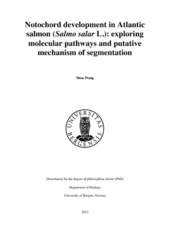| dc.contributor.author | Wang, Shou | eng |
| dc.date.accessioned | 2014-03-25T08:49:58Z | |
| dc.date.available | 2014-03-25T08:49:58Z | |
| dc.date.issued | 2014-03-07 | eng |
| dc.identifier.isbn | 978-82-308-2955-4 | en_US |
| dc.identifier.uri | http://hdl.handle.net/1956/7888 | |
| dc.description.abstract | Background: A key feature of the vertebrate body plan is the repeated compartments made up of individual vertebra, blood vessels, peripheral nerves and muscle. The vertebral column comprises a series of bony vertebral bodies with arches and intervertebral discs and joints. However, the biological mechanisms that generate this segmental pattern during embryogenesis are not fully understood. Unlike amniotes, teleosts display segmented mineralization in the notochord sheath, as the initial morphogenic step in the formation of the vertebral column. It has been hypothesized that the notochord initiates its early segmentation, and thus patterns the vertebral column in teleosts. In order to determine whether the notochord is functionally segmented, this project studied all the genes expressed in the notochord prior to and during the early stages of segmentation. Studies of this type may provide further clues to the patterning of notochord segmentation in fish and possible other vertebrates. Methods A micro-dissection protocol was developed to isolate the pure cellular core of the notochord, and the rest of tissues from Atlantic salmon larvae for total RNA extraction. Two DNA-sequencing technologies, EST sequencing and RNA-seq, were employed to identify the notochord-specific transcriptome in salmon. Quantitative gene expression analysis (Q-PCR) was performed on genes of interest, and spatial gene expression in the notochord was investigated by means of in situ hybridization. Meanwhile, TEM was used for detailed characterization of the pattern of mineralization in the collagen matrix in the notochord sheath, as well as on the outside. Synchrotron radiation based X-ray diffraction was performed in order to analyze the identity of the mineralized elements in the notochord sheath. Results Mineralized ring-structures of the vertebral centra were first observed in the type II collagen matrix of the notochord sheath, and slightly later in the type I collagen matrix with sclerotomal origin. The nucleation and growth pattern of hydroxyapatite crystals were similar in both type I and type II collagen matrices. The crystals always grew as thin flakes along the long axis of the collagen fibrils, while the production of major collagen transcripts significantly decreased over time. RNA-seq of notochord samples before and during initial segmentation of notochord confirmed the down-regulation of genes involved in collagen fibrillogenesis and many other pathways during early segmentation of the notochord. At this developmental stage, col11a2 was expressed in a segmental pattern in one chordoblast population adjacent to the non-mineralized zone in the notochord sheath corresponding to the intervertebral region. Two genes (vimentin- and elastin-like transcripts) were found to be uniquely expressed in the notochord during early mineralization. In-situ results showed that the vimentin-like gene was expressed in the vacuolated chordocytes and in the chordoblasts lining the notochord sheath. The expression of the elastin-like gene was only found in the chordoblasts. A colinear expression of 71 Hox genes along the anterior-posterior axis of the notochord was also observed. Typical chondrogenic genes, but no osteogenic genes, were expressed in the salmon notochord, indicating a close relationship between the notochord and cartilage. Conclusions A few structural genes were found to be exclusively expressed in the notochord. A dramatic change of gene regulation in whole-genome scale occurs at the onset of notochord segmentation. Meanwhile, segmental expression of col11a2 was found in chordoblasts lining prospective non-mineralized regions of the notochord. Moreover, the initial mineralization of the vertebral body was preceded by hydroxyapatite accreting in a segmental pattern in the notochord sheath in salmon. There was both morphological and molecular evidence of a segmentation process in the developing notochord, which contributes to the segmental patterning and initial development of the vertebra and intervertebral region in Atlantic salmon. | en_US |
| dc.language.iso | eng | eng |
| dc.publisher | The University of Bergen | en_US |
| dc.relation.haspart | Paper I: Sagstad, A., Grotmol, S., Kryvi, H., Krossøy, C., Totland, G. K., Malde, K., Wang, S., Hansen, T., Wargelius, A., 2011. Identification of vimentin- and elastin-like transcripts specifically expressed in developing notochord of Atlantic salmon (Salmo salar L.). Cell and Tissue Research 346, 191-202. Full-text not available in BORA. The published version is available at: <a href="http://dx.doi.org/10.1007/s00441-011-1262-y" target="blank">http://dx.doi.org/10.1007/s00441-011-1262-y</a> | en_US |
| dc.relation.haspart | Paper II: Wang, S., Furmanek, T., Kryvi, H., Krossøy, C., Totland, G. K., Grotmol, S., Wargelius, A., 2014. Transcriptome sequencing of Atlantic salmon (Salmo salar L.) notochord prior to development of the vertebrae provides clues to regulation of positional fate, chordoblast lineage and mineralization. (Submitted manuscript). The paper is available here: <a href="http://hdl.handle.net/1956/7889" target="blank">http://hdl.handle.net/1956/7889</a> | en_US |
| dc.relation.haspart | Paper III: Wang, S., Kryvi, H., Grotmol, S., Wargelius, A., Krossøy, C., Epple, M., Neues, F., Furmanek, T., Totland, G., 2013. Mineralization of the vertebral bodies in Atlantic salmon (Salmo salar L.) is initiated segmentally in the form of hydroxyapatite crystal accretions in the notochord sheath. Journal of Anatomy 223, 159-170. Full-text not available in BORA. The published version is available at: <a href="http://dx.doi.org/10.1111/joa.12067" target="blank">http://dx.doi.org/10.1111/joa.12067</a> | en_US |
| dc.subject | Notochord | eng |
| dc.subject | col11a2 | eng |
| dc.subject | RNA-seq | eng |
| dc.subject | Segmentation | eng |
| dc.subject | Atlantic salmon | eng |
| dc.title | Notochord development in Atlantic salmon (Salmo salar L.): exploring molecular pathways and putative mechanism of segmentation | en_US |
| dc.type | Doctoral thesis | |
| dc.rights.holder | Copyright the author. All rights reserved | en_US |
